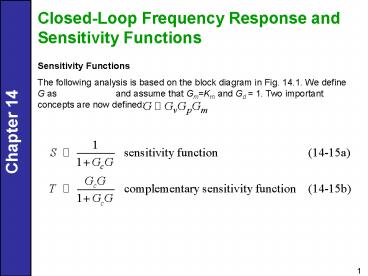ClosedLoop Frequency Response and Sensitivity Functions - PowerPoint PPT Presentation
1 / 13
Title:
ClosedLoop Frequency Response and Sensitivity Functions
Description:
Ziegler-Nichols tuning (Table 12.6) Tyreus-Luyben tuning (Table 12.6) ... Ziegler-Nichols. MT. Kc. Controller. Controller Settings for Example 14.8. 13. Chapter 14 ... – PowerPoint PPT presentation
Number of Views:193
Avg rating:3.0/5.0
Title: ClosedLoop Frequency Response and Sensitivity Functions
1
Closed-Loop Frequency Response and Sensitivity
Functions
Sensitivity Functions The following analysis is
based on the block diagram in Fig. 14.1. We
define G as and assume that
GmKm and Gd 1. Two important concepts are now
defined
2
Comparing Fig. 14.1 and Eq. 14-15 indicates that
S is the closed-loop transfer function for
disturbances (Y/D), while T is the closed-loop
transfer function for set-point changes (Y/Ysp).
It is easy to show that
As will be shown in Section 14.6, S and T provide
measures of how sensitive the closed-loop system
is to changes in the process.
- Let S(j ) and T(j ) denote the amplitude
ratios of S and T, respectively. - The maximum values of the amplitude ratios
provide useful measures of robustness. - They also serve as control system design
criteria, as discussed below.
3
- Define MS to be the maximum value of S(j )
for all frequencies
The second robustness measure is MT, the maximum
value of T(j )
MT is also referred to as the resonant peak.
Typical amplitude ratio plots for S and T are
shown in Fig. 14.13. It is easy to prove that MS
and MT are related to the gain and phase margins
of Section 14.4 (Morari and Zafiriou, 1989)
4
Figure 14.13 Typical S and T magnitude plots.
(Modified from Maciejowski (1998)). Guideline.
For a satisfactory control system, MT should be
in the range 1.0 1.5 and MS should be in the
range of 1.2 2.0.
5
It is easy to prove that MS and MT are related to
the gain and phase margins of Section 14.4
(Morari and Zafiriou, 1989)
6
Bandwidth
- In this section we introduce an important
concept, the bandwidth. A typical amplitude ratio
plot for T and the corresponding set-point
response are shown in Fig. 14.14. - The definition, the bandwidth ?BW is defined as
the frequency at which T(j?) 0.707. - The bandwidth indicates the frequency range for
which satisfactory set-point tracking occurs. In
particular, ?BW is the maximum frequency for a
sinusoidal set point to be attenuated by no more
than a factor of 0.707. - The bandwidth is also related to speed of
response. - In general, the bandwidth is (approximately)
inversely proportional to the closed-loop
settling time.
7
Figure 14.14 Typical closed-loop amplitude ratio
T(j?) and set-point response.
8
Closed-loop Performance Criteria Ideally, a
feedback controller should satisfy the following
criteria.
- In order to eliminate offset, T(j?)? 1 as ? ?
0. - T(j?) should be maintained at unity up to as
high as frequency as possible. This condition
ensures a rapid approach to the new steady state
during a set-point change. - As indicated in the Guideline, MT should be
selected so that 1.0 lt MT lt 1.5. - The bandwidth ?BW and the frequency ?T at which
MT occurs, should be as large as possible. Large
values result in the fast closed-loop responses.
Nichols Chart The closed-loop frequency response
can be calculated analytically from the open-loop
frequency response.
9
Figure 14.15 A Nichols chart. The closed-loop
amplitude ratio ARCL ( ) and phase
angle are shown in families of
curves.
10
Example 14.8 Consider a fourth-order process with
a wide range of time constants that have units of
minutes (Åström et al., 1998)
Calculate PID controller settings based on
following tuning relations in Chapter 12
- Ziegler-Nichols tuning (Table 12.6)
- Tyreus-Luyben tuning (Table 12.6)
- IMC Tuning with (Table
12.1) - Simplified IMC (SIMC) tuning (Table 12.5) and a
second-order plus time-delay model derived using
Skogestads model approximation method (Section
6.3).
11
Determine sensitivity peaks MS and MT for each
controller. Compare the closed-loop responses to
step changes in the set-point and the disturbance
using the parallel form of the PID controller
without a derivative filter
Assume that Gd(s) G(s).
12
Controller Settings for Example 14.8
13
Figure 14.16 Closed-loop responses for Example
14.8. (A set-point change occurs at t 0 and a
step disturbance at t 4 min.)































